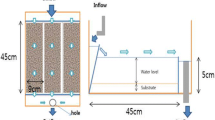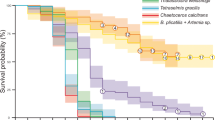Abstract
We conducted feeding experiments on threadsail filefish Stephanolepis cirrhifer juveniles for 16 days to evaluate the efficacy of moon jellyfish Aurelia aurita as a prey item. Four treatments, each with 40 individuals, were prepared to compare fish growth performance. The treatments consisted of filefish that were starved (control) (S), fed only jellyfish (J), fed only krill (K), and fed both jellyfish and krill (JK). Fish in the S treatment exhibited a 50% mortality rate and reduced body weight, whereas the J treatment exhibited a zero mortality rate and increased body weight. Fish in the JK treatments showed a significantly faster growth than those in the K treatment. Filefish consumed as much as 24 and 13 times their own body weight in jellyfish per day in the J and JK treatments, respectively. This is the first report showing that growth can be sustained by feeding a marine fish only jellyfish, and indicates the potential of jellyfish as a fish prey in both nature and captivity.


Similar content being viewed by others
References
Graham WM (2001) Numerical increases and distributional shifts of Chrysaora quinquecirrha (Desor) and Aurelia aurita (Linne) (Cnidaria Scyphozoa) in the northern Gulf of Mexico. Hydrobiologia 451:97–111
Brodeur RD, Sugisaki H, Hunt GL (2002) Increases in jellyfish biomass in the Bering Sea: implications for the ecosystem. Mar Ecol Prog Ser 233:89–103
Purcell JE (2003) Predation on zooplankton by large jellyfish, Aurelia labiata, Cyanea capillata and Aequorea aequorea, in Prince William Sound, Alaska. Mar Ecol Prog Ser 246:137–152
Purcell JE, Uye S, Lo W (2007) Anthropogenic causes of jellyfish blooms and their direct consequences for humans: a review. Mar Ecol Prog Ser 350:153–174
Arai MN (2005) Predation on pelagic coelenterates: a review. J Mar Biol Ass UK 85:523–536
Suazo CG (2008) Black-browed albatross foraging on jellyfish prey in the southeast Pacific coast, southern Chile. Polar Biol 31:755–757
Holland D, Davenport J, East J (1990) The fatty acid composition of the leatherback turtle Dermochelys coriacea and its jellyfish prey. J Mar Biol Ass UK 70:761–770
Masuda R, Yamashita Y, Matsuyama M (2008) Jack mackerel Trachurus japonicus juveniles use jellyfish for predator avoidance and as a prey collector. Fish Sci 74:276–284
Purcell JE, Arai MN (2001) Interaction of pelagic cnidarians and ctenophores with fish: a review. Hydrobiologia 451:27–44
Runge JA, Pepin P, Silvert WS (1987) Feeding behavior of the Atlantic mackerel Scomber scombrus on the hydromedusa Aglantha digitale. Mar Biol 94:329–333
Möller H (1980) Population dynamics of Aurelia aurita medusae in Kiel Bight, Germany (FRG). Mar Biol 60:123–128
Lucas CH (1994) Biochemical composition of Aurelia aurita in relation to age and sexual maturity. J Exp Mar Biol Ecol 183:179–192
Fukuda Y, Naganuma T (2001) Potential dietary effects on the fatty acid composition of the common jellyfish Aurelia aurita. Mar Biol 138:1029–1103
Folch J, Lees M, Stanley GH (1957) A simple method for the isolation and purification of total lipids from animal tissues. J Biol Chem 226:497–509
Juaneda P, Rocquelin G (1985) Rapid and convenient separation of phospholipids and non phosphorus lipids from rat-heart using silica cartridges. Lipids 20:40–41
Ratnayake WMN, Ackman RG (1985) Rapid analysis of canola gum lipid composition by Iatroscan thin layer chromatography-flame ionization detection. Can Inst Food Sci Technol J 18:284–289
Morrison WR, Smith LM (1964) Preparation of fatty acid methyl esters and dimethylacetals from lipids with boron fluoride-methanol. J Lipid Res 5:600–608
Yamashita Y, Bailey KM (1989) A laboratory study of the bioenergetics of larval walleye pollock, Theragra chalcogramma. Fish Bull 87:525–536
Schabetsberger R, Morgan CA, Brodeur RD, Potts CL, Peterson WT, Emmett RL (2003) Prey selectivity and diel feeding chronology of juvenile chinook (Oncorhynchus tshawytscha) and coho (O. kisutch) salmon in the Columbia River plume. Fish Oceanogr 12:523–540
Bamstedt U, Martinussen MB (2000) Estimating digestion rate and the problem of individual variability, exemplified by a scyphozoan jellyfish. J Exp Mar Biol Ecol 251:1–15
Ovchinnikova TV, Balandin SV, Aleshina GM, Tagaev AA, Leonova YF, Krasnodembsky ED, Men’shenin AV, Kokryakov VN (2006) Aurelin, a novel antimicrobial peptide from jellyfish Aurelia aurita with structural features of defensins and channel-blocking toxins. Biochem Biophys Res Commun 348:514–523
Zheng F, Takeuchi T, Yoseda K, Hirokawa J, Watanabe T (1995) Changes in fatty acid composition during developmental stages of cod larvae in mass production. Nippon Suisan Gakkaishi 61:756–761
Nichols PD, Danaher KT, Koslow JA (2003) Occurrence of high levels of tetracosahexaenoic acid in the jellyfish Aurelia sp. Lipids 38:1207–1210
Acknowledgments
We are grateful to Dr. Michelle Walsh and Dr. Dominique Robert for providing constructive comments on early versions of the manuscript. Comments from the editor and reviewers also improved the quality of the manuscript. This study was financially supported by the STOPJELLY project from the Agriculture, Forestry and Fisheries Research Council.
Author information
Authors and Affiliations
Corresponding author
Rights and permissions
About this article
Cite this article
Miyajima, Y., Masuda, R., Kurihara, A. et al. Juveniles of threadsail filefish, Stephanolepis cirrhifer, can survive and grow by feeding on moon jellyfish Aurelia aurita . Fish Sci 77, 41–48 (2011). https://doi.org/10.1007/s12562-010-0305-8
Received:
Accepted:
Published:
Issue Date:
DOI: https://doi.org/10.1007/s12562-010-0305-8




